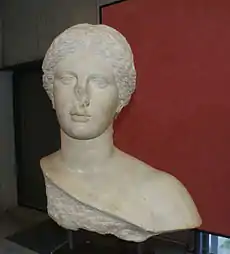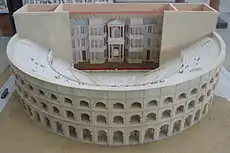Head of Arles
The Head of Arles (French: Tête d'Arles), formerly known also as the Head of Livia (Tête de Livie) or the Head with the broken nose (Tête au nez cassé) is a fragment of a Roman marble statue in two parts, of which only the bust remains, which probably depicts Venus (Aphrodite) and was discovered in the ruins of the Ancient Theatre of Arles in 1823 during the removal of accreted material from the theatre. The Head of Arles represents an iconographic type called Aspremont-Lynden/Arles. It is now part of the permanent exhibition of the Musée de l'Arles et de la Provence antiques with the inventory number FAN.92.00.405.

Fragment of a theatrical decoration
The sculpture was originally two separate pieces, joined at an angle across the chest in a manner which is also seen elsewhere.[1] The bust which is preserved today, with a height of 57 cm was probably inserted into an entirely clothed body, with her posture causing the chiton to slip off the left shoulder.[2] As was usual, the statue was painted and the hair in particular was probably gilded.[3]
The bust was discovered in 1823 at the same time as a bas-relief representing Apollo and Marsyas in a trench dug in a road near the location of the ancient theatre of Arles.[4] Given the location of its discovery, the statue was taken to be part of the decoration of the postscaenium which decorated the stage building of the ancient theatre, probably located in one of the niches which flanked the royal gate (valva regia), mirroring the Venus of Arles, which was found near this location some two centuries earlier and together framing the monumental statue of Augustus in the guise of Apollo, to whom the theatre was dedicated.[5] Like the Venus of Arles, the Head of Arles has a hole at the front of head which probably allowed the attachment of a metal star or diadem, a fact which suggests that the two statues were originally designed as a pair.[6]

The two statues,[7] with that of Augustus, have formed part of the permanent collection of the Musée de l'Arles antique since its creation in 1995. Before that, they were displayed in the Musée lapidaire d'Arles.[8] The Head of Arles, also known as the Noseless Head (Tête sans nez) was presented at the exhibition of fine arts in Marseilles in 1861.[9]
Dating and classification
On account of the "exceptional" artistic quality that is recognisable in this bust,[10] the study of the head has drawn connections with the Greek statues of the end of the Fifth century or beginning of the Fourth century BC. Particular features which are noted include the bust's banded tresses tightly tied in a low bun, the heaviness of the lower part of the face and the deep shading of the area around the eyes. Cécile Carrier argues that it is probably based on a model which pre-dates Praxiteles,[11] agreeing with the position earlier advanced by Salomon Reinach.[12] Other authors, like Antonio Corso, associate the bust with the sculpture of Phryne of Thespiae carved by Praxiteles.[13] Either way, all scholars agree that the Head of Arles itself is Roman copy, made in the Antonine period at the latest and most likely in the Augustan period (First century AD).[11]
The Head was formerly identified as a depiction of the Empress Livia, wife of Augustus who was later deified (as a result of which it was called the "Head of Livia")[14] but it follows an iconographic type which is more closely associated with Venus Genetrix, the victorious goddess invoked by Julius Caesar.[11]
The use of the type of Venus Genetrix can be interpreted as a gesture of filial piety on the part of Augustus for his adoptive father, but there is also a more local symbolism - a homage to Caesar's foundation of the Colony of Arles, stressed by Augustus when he renamed the city Colonia Julia Paterna.[15] Like the other two statues which decorated the postscaenium of the ancient theatre (the deified Augustus in the role of Apollo and the Venus of Arles which may represent Venus Victrix) the Head of Arles conforms to the official iconographic style which was established after the end of the Roman Republic and propagated especially in the Augustan period.[15]
The Aspremont-Lynden/Arles type, of which the Head of Arles is the best example, includes a number of Roman replicas of Greek statues of which only the heads are preserved.[16] The other examples are:
- The Aspremont-Lynden Head at Vienne,[17]
- The Head of the Tower of the Winds in Athens,[18]
- The Head of Chios at Boston,[19]
- The Female Head at Civitavecchia.[20]
Some other connections are possible, such as the Kaufmann Head (Louvre) and the Leconfield Head (Petworth House). If the Head of Arles does derive from a pre-Praxitelean model connections can also be made with the Head with the broken nose of the Aphrodite of Cnidus type (also in the Louvre)[21] and the Martres-Tolosane Head (Toulouse).[22]
References
- This process, along with the treatment of the uncovered left shoulder, connects the Head of Arles with the headless sculpture known as Aphrodite on a tortoise kept in Berlin, which has a bust serparated from its body in the same way, according to Patrimoine de la ville d'Arles : Buste d'Aphrodite. See also the note under the bust at the Musée de l'Arles antique : Illustration on Wikimedia Commons
- Cécile Carrier proposed this theory on the basis of models in Greek sculpture developed from the mid-fifth century BC, such as the representations of Aphrodite and Artemis on the front of the Parthenon "Sculptures augustéennes du théâtre d'Arles," Revue archéologique de Narbonnaise, 2005, volume 38, N° 38–39, p. 375
- Louis Jacquemin notes that, like the Venus of Arles, some traces of a coat of red paint which was used during the process of gilding marble remain ("Monographie du théâtre antique d'Arles", Typographie Dumas et Dayre, Arles, Vol. II, Chapter VI, 1863, p. 371)
- Jacques Joseph and Jean-François Champollion, "Bulletin des sciences historiques, antiquité, philologie," Journal des débats, 5 mars 1826, vol. 5, Paris, Imprimerie de Fain, 1826, p. 301
- Jules Formigé, "Note sur la Vénus d'Arles", Comptes-rendus de l'Académie des Inscriptions et Belles-Lettres no 39 (1911), p. 663. Cécile Carrier, op. cit., p. 377
- See Cécile Carrier, op. cit., p. 377
- A plaster copy of the Venus of Arles in its original state (without arms) is on display in Arles. The real Venus (in marlbe) is in the Louvre with arms added by Girardon
- The Head was displayed with the copy of the Venus of Arles in the nave of the old church, on either side of the tomb of Yppolyte. Cf. AN.-E Agard, "Le Musée Lapidaire d'Arles," Imprimerie générale du Sud-Ouest - J. Castanet, janvier 1924, p. 16 (read online)
- Louis Jacquemin, op. cit., p. 382. See also : Marius Chaumelin, Les Trésors d’art de la Provence exposés à Marseille en 1861 (Paris, 1862) and Concours régional, 1861. Exposition des beaux-arts. Marseille. Livret des tableaux, dessins, gravures, sculptures et curiosités, Éditeur Galerie de l'Exposition, 1861. Discussing the exhibition, Frédéric Mistral mentions the "tête sans nez" in revue Armana prouvençau 1862, pp. 40–50
- See : Patrimoine de la ville d'Arles : bust of Aphrodite. For his part, Louis Jacquemin who praised the bust in the nineteenth century, judged that it was a "marvel of sculptural technique (which inspires) the admiration of experts" and called it one of the "masterpieces of Greek art" in which the details are "perfect," op. cit., p. 382. Similar sentiments are found in the Champollions' piece in the Bulletin des sciences historiques, antiquité, philosophie: "It is comparable to all the most beautiful and most finished products of the Greek chisel, even in the most vigorous periods" (op. cit., p. 301)
- See Cecile Carrier, op. cit., p. 375
- Salomon Reinach, « Recueil de têtes antiques idéales ou idéalisées » Gazette des Beaux-Arts, 1903, pl. 136 et p. 105
- Antonio Corso, "The art of Praxiteles. The development of Praxiteles'workshop and its cultural tradition until the sculptor's acme, (364–1 BC)," Rome, L'Erma de Bretchneider, 2004, pp. 257–280 – See also, implicitly, Emmanuel Daydé, "Exposition. Praxitèle aphrodisiaque", Artabsolument, n0° 21, été 2007, p. 45 (Online version)
- e.g. Jean-Julien Estrangin, Études archéologiques, historiques et statistiques sur Arles, Aubin éditeur, 1838, pp.116-118; Louis Jacquemin, op. cit., p. 299 ; Jules Formigé, op. cit., p. 663. But note that the Champollions in 1826 (op. cit, p. 301) and André Férussac in 1828 (Bulletin des sciences historiques, antiquités, philologie, Paris, p. 446) identified it as a bust of Diana. It has also been known as the "Noseless Head" or the "Head with the broken nose", e.g. Arles by L.-G. Pélissier ; Claude Sintes, Vicissitudes d’un théâtre antique p. 3–4] ; Jean-Marie Rouquette, "Les tumultueuse amours du patrimoine", Bulletin des Amis du Viel Arles, N° 105, décembre 1999, p. 14)
- See Cécile Carrier, op. cit., p. 376
- Cécile Carrier lists the four examples which survive, op. cit, p. 376
- Published by Francis Croissant, "Une Aphrodite méconnue du début du IVe siècle," in Bulletin de correspondance hellénique, 1971, Vol. 95, N° 95-1, pp. 65–107
- Published by H. Lauter, "Der praxitelische Kopf Athen, Nationalmuseum 1762," Antike Plastik, 19, 1988, pp. 21–29 ; C. Picard, Manuel d'archéologue grecque: La sculpture. Tome 3 : Période classique, IV° s., Paris, 1948–1966, 4 vol., pp. 486–488 ; B. S. Ridgway, "The Aphrodite of Arles," in American Journal of Archæology, vol. 80, n°2, 1976, pp. 153–154 – Image on Wikimedia Commons
- Published by H. Lauter, op. cit, p. 24
- Published by H. Lauter, op. cit., pp. 21, 23–29
- Illustration on wikimedia Commons
- "Illustration on the website of the Musée Saint-Raymond". Archived from the original on 2014-01-27. Retrieved 2014-09-21.
Bibliography
- (in French) Fernand Benoit, Le musée lapidaire d'Arles, Henri Laurens éditeur, 1936
- Cécile Carrier
- (in French) Programmes iconographiques dans les monuments publics de Gaulle Narbonnaise (Ier siècle av. J. C. - IIe siècle après J. C.), Doctoral thesis, Université de Provence, Aix-Marseille 1, 2000 (Supervised by Pierre Gros)
- (in French) "Sculptures augustéennes du théâtre d'Arles" Revue archéologique de Narbonnaise, 2005, volume 38, pp. 374–377. (Available online).
- Jacques Joseph and Jean-François Champollion, Bulletin des sciences historiques, antiquité, philologie, Journal des débats, 5 March 1826, Vol. 5, Paris, Imprimerie de Fain, 1826, p. 301.
- Antonio Corso, "The triad of Thespiae" in The art of Praxiteles. The development of Praxiteles'workshop and its cultural tradition until the sculptor's acme (364–1 BC), Rome, L'Erma de Bretchneider, 2004, pp. 257–280.
- (in French) Francis Croissant, "Une Aphrodite méconnue du début du IVe siècle," Bulletin de correspondance hellénique, 1971, Vol. 95-1, pp. 65–107 (Persée.fr Available online)
- (in French) Marius Chaumelin, Les Trésors d’art de la Provence exposés à Marseille en 1861, Paris, 1862.
- Jean Julien Estrangin, Études archéologiques, historiques et statistiques sur Arles, Aubin éditeur, 1838, especially p. 116–118 (Available online)
- Jules Formigé, "Note sur la Vénus d'Arles," Comptes-rendus de l'Académie des Inscriptions et Belles-Lettres 39 (1911), especially p. 663. (Persée.fr Available online)
- Louis Jacquemin, Monographie du théâtre antique d'Arles, Typographie Dumas et Dayre, Arles, tome II, Chapitre VI, 1863, p. 299, 371 & 382 (Available online)
- (in German) Hugh Lauter, "Der praxitelische Kopf Athen, Nationalmuseum 1762," Antike Plastik, 19, 1988, p. 21–29
- (in French) Charles Picard, Manuel d'archéologue grecque. La sculpture. Tome 3 : Période classique, IVe, Paris, 1948–1966, 4 vol., p. 486–488
- Salomon Reinach, "Recueil de têtes antiques idéales ou idéalisées," Gazette des Beaux-Arts, 1903, pl. 136 & p. 105
- Brunilde Sismondo Ridgway, "The Aphrodite of Arles," American Journal of Archæology, vol. 80-2, 1976, p. 153–154
External links
- Official website of the Musée départemental Arles antique (in French, German, English, Spanish, and Italian)
- Patrimoine de la ville d'Arles : Buste d'Aphrodite (in French)